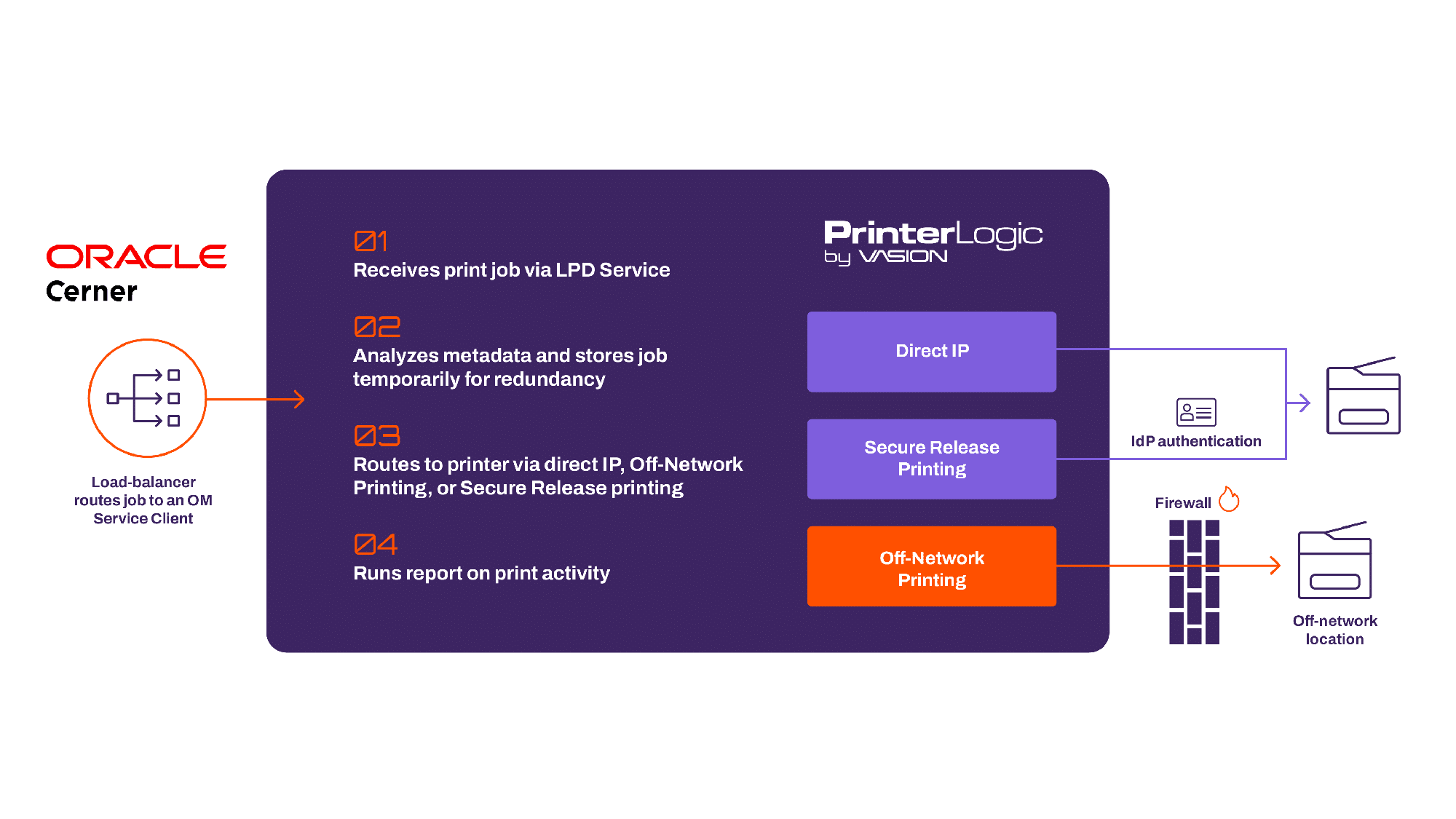This blog is one of a three-part Output Management series about the Oracle Cerner, Epic, and SAP connectors. Read the other installments on Epic and SAP here.
PrinterLogic’s healthcare customers value our serverless printing solution for the secure, unified print management it provides. We help simplify the complexity of conducting general office printing alongside EHR/EMR solutions, which almost always come with their own print infrastructure and framework.
As part of our efforts to make that day-to-day experience even better for all healthcare personnel, while reducing the load on IT admins, we’ve developed tools to better manage back-end Oracle Cerner electronic health record (EHR) printing and overall front-end output.
The LPD Service is the bridge between Oracle Cerner EHR software and your printers, and has big benefits of convenience and ease of use for healthcare organizations.
Let’s dig in a little deeper.
The line printer daemon (LPD) is part of a standard software protocol that allows networked computers to submit print jobs to printers on the same network. The LPD is the liaison responsible for relaying print jobs to the network printer.
The PrinterLogic LPD Service works by identifying a service client device on the network that is running the standard PrinterLogic client agent. It runs in the background and listens for compatible print jobs.
Once the LPD Service has been enabled by an admin, it can receive LPD print traffic and extract information from the print job’s bundled metadata. That data includes who printed the job, which printer it’s targeting, as well as details like finishing options (e.g., duplex, B/W, output tray) and secure release settings. Based on that metadata, the print job will be routed to the correct printer, including off-network configured printers, and/or held for release if requested.
The same metadata is also used for PrinterLogic’s reporting functionality. Details like the initiating user, destination printer, timestamp, and filename are collected and uploaded to the PrinterLogic Admin Console.
Behind the curtain information: The PrinterLogic LPD Service will first try to send the job to the printer without using a driver via the Internet Printing Protocol (IPP). IPP is another printing standard that supports advanced capabilities like access control, authentication, and encryption. If IPP isn’t supported on the printer, you can use any signed Type 3 printer driver instead.

What does the LPD Service offer Oracle Cerner and print management?
Oracle Cerner provides one of the world’s leading EHR solutions for the healthcare industry to access and securely maintain vast data stores of confidential patient medical information. By design, it also becomes the central source of printing for the organization, as almost every record originates from or passes through Oracle Cerner before it’s printed.
Unfortunately, this can cause issues with general office printing and back-end applications, because Oracle Cerner has its own server-based print infrastructure. Device incompatibilities, downtime, and routine printing errors are common occurrences that multiply in IT environments with diverse printer fleets.
PrinterLogic’s LPD Service leverages the universal line print remote (LPR) printing standard—the same one that Oracle Cerner’s own EHR system uses—to enable users to print from back-end applications without the need for legacy print servers, sidestepping all the problems inherent to those print servers. Additionally, with PrinterLogic’s advanced printing features, IT admins get even more control over printing:
- Comprehensive reporting: See who printed what, when, where, and why.
- Secure Release/pull printing: Jobs are held until the user has authenticated their identity at the printer to release them. This keeps protected health information (PHI) from sitting unclaimed in print trays accessible to anyone.
- Off-Network Printing: Conveniently allow devices to print, without direct access to your network, while maintaining strict Zero Trust policies.
These features complement the stringent security requirements of EHR systems and enable organizations to maintain compliance with HIPAA and other industry regulations.
The LPD Service also increases with print resiliency to avoid downtime. Multiple PrinterLogic LPD Service clients can be used to create redundancy. These can be set up behind a load balancer or configured to communicate amongst themselves for failover scenarios.
Availability
The PrinterLogic LPD Service is available in our Output Management Bundle, an add-on license to the core print feature set. The service supports connections with Oracle Cerner, Epic, and SAP systems to provide organizations control over everything they print. Stay tuned for exciting features coming soon that include automations to increase uptime and avoid disruption to your business-critical printing.
Additionally, Off-Network Printing and Secure Release Printing are available in our Advanced Security Bundle to help you adopt Zero Trust principles and practices.
A Complete Solution for Printing and Print Management
The LPD Service is just one benefit among many that PrinterLogic offers to healthcare organizations. With our serverless printing solution, you can:
- Lower costs: Fragmented solutions and all the required support infrastructure can lead to mounting costs. By minimizing the hardware footprint and eliminating deep-rooted print inefficiencies, PrinterLogic keeps costs down.
- Simplify print management: It can be difficult to bridge the different systems for EMR and general office printing. PrinterLogic helps to unify the print environment and provides a single window for IT to oversee it.
- Harden security: Thanks to its Secure Release and Off-Network Printing functionality, PrinterLogic increases the security of Oracle Cerner and similar EMR/EHR solutions without sacrificing ease of use.
- Provide insights: In addition to capturing extensive metadata for every print job, PrinterLogic offers a convenient way to view, filter, and sort that information. IT can easily monitor print activity across the organization.
Interested in eliminating all of your print servers?
We deliver a highly available serverless printing Infrastructure using a centrally-managed direct IP printing platform. If you want to empower end users with mobile printing, Secure Release Printing, and many advanced features, we’d love to show you how.

